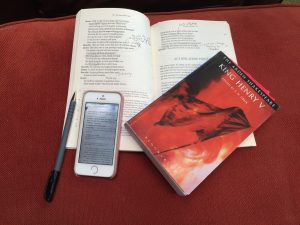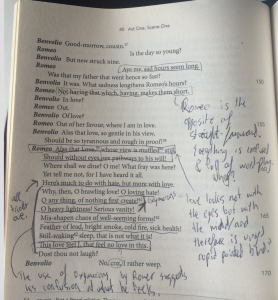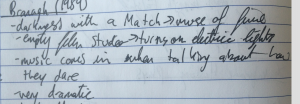It comes as no surprise that watching a Shakespeare film is inherently different than reading a Shakespeare play. The two mediums engage our minds differently. Thus, when we go to annotate the two, we approach from different angles. I personally am much more successful at annotating texts. The reason for this is two-fold; when reading a text I am both able to work through it at my own pace and able to physically make notes on it.
Texts give the reader the liberty of time. There is no penalty to be paid for re-reading passages or pausing to write down thoughts, opinions and impressions. Every word appears before the reader and can be quickly defined if needed. When I annotate a text I sit with the book on my lap, a pen in my hand, and my phone within reach so words can be defined and questions addressed if desired. In this position I seamlessly shift between annotating and reading allowing for thorough meditation on the work.


I find this factor of time changes when I go to annotate film. The difference is that film comes at you much faster. The scene is always growing and changing without pause to understand the rich, and often archaic, language. There is no time to look up words or mediate on scenes. Even the simplest annotations are difficult because while I am writing them I miss the new scene unfolding on the screen. Annotating does not help me to connect and interpret lines, but rather it functions as a distraction when viewing films.
In part the lack of success I have in annotating film compared to text is due to the fact I annotate both on paper. For text this works. The text serves as a guideline that can be underlined for emphasis, joined to show connection, circled or questioned, and then further thoughts expanded on in the margins. All of the original words are there to be revisited at any moment as new perspectives surface.

This page from act II scene 2 of Romeo and Juliet serves as an example of my annotation process. Textual elements, for example the oxymorons at the bottom of the page, are first identified and then grouped together. If the grouping then suggests something about the character or the scene I jot down a quick note of interpretation. If I cannot see some purpose to the textual elements of the passage I will write questions or question marks to help me identify what it is I do not understand. This specific page contains interesting annotations because here I have likened lines 158-159 to lines from A Midsummer Night’s Dream. These types of connections expand and enrich the meanings of passages.
Without the text to use as a template, this style of annotation falls apart. There simply is nothing there to underline, circle, connect, or manipulate. Working on a blank page is slower and harder to revisit. Compounding the issue, the medium of film comes at you faster than text so I miss details in the first place. The movement between watching the screen and annotating on paper also impacts the quality of annotation. The two headspaces do not blend together as annotating and reading a text does. Perhaps a more successful way to annotate a film could be done using a computer. If the film were on side of a computer screen and a blank document on the other side the transition between would be smaller. However, this still does not slow the pace of film viewing, or provide any template to work with.
The last and largest difference between how I annotate text and film is the type of annotations I make. With text I look at the language annotating for content, connections, and clarity. However, when annotating film my annotations denote elements of film such as acting, editing, music, and setting. Precious few annotations have to do with language. Instead of delving into the textual elements of the language or even themes of the narrative, I find myself focussing on the visual interpretation. This of course stems from the fact that film is a visual medium. I naturally gravitate towards noting how the characters are presented as oppose to what they actually say. Snippets of my annotations of Branagh’s Much Ado About Nothing and his Henry V exemplify the content of film annotation. The examples note shots, music, and acting. These annotations contain few, if any, references to dialogue.


Annotation serves to help make sense of something as a whole. Physically annotating a text allows for freedom to manipulate it in search of patterns, analyze the textual elements, and add layers of thoughts and interpretations to the same literal page. This is a successful method of annotation because it allows the reader time to recognize different elements and to draw conclusions from them. Annotating a film is not something that I have mastered. The distracting switch between watching and annotating on paper steals the value of the annotations because the sequent parts of the film are missed. The actual content of text annotations and film annotations is extremely different. Text focuses on the verbal content whereas film focuses on the visual content. This is not unexpected as text is a verbal medium and film in a visual medium. My personal text annotation style is successful in this, however, my film annotation style is not.
Aspen Kozak
Leave a Reply
You must be logged in to post a comment.